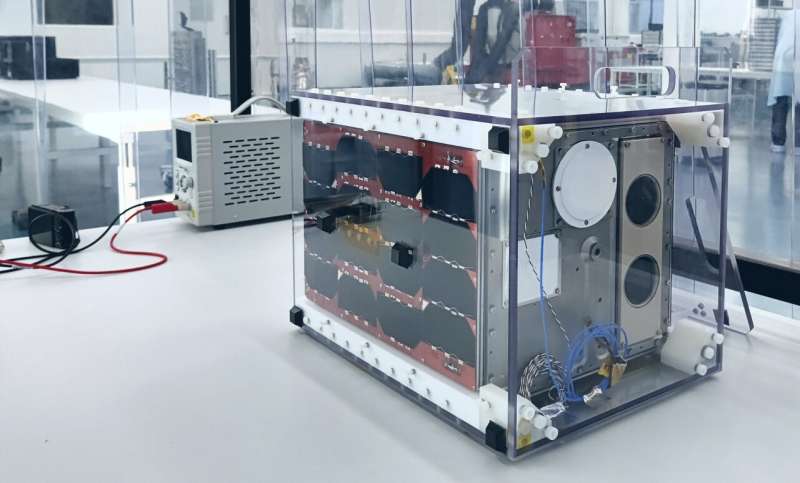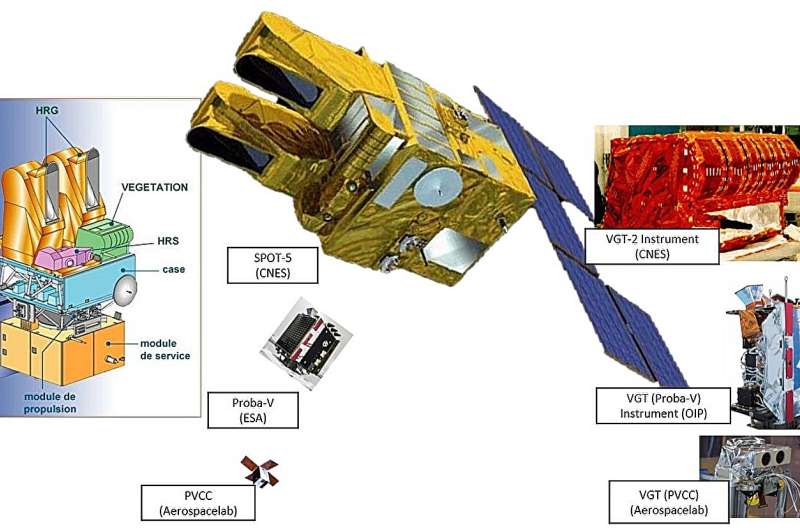This article has been reviewed according to Science X's editorial process and policies. Editors have highlighted the following attributes while ensuring the content's credibility:
fact-checked
trusted source
proofread
Big Earth imager to be tested on small Vega CubeSat

A briefcase-sized CubeSat being flown on Europe's next Vega launcher this week will gather 340 km wide views of Earth's vegetation growth, employing a spectral imager originally designed for ESA's decade-in-flight Proba-V.
The Proba-V Companion CubeSat has been built by "NewSpace" company Aerospacelab in Belgium, hosting a Proba-V spectral imager provided by OIP Space Instruments and Belgium's VITO research institute processing and making use of its data. The goal of the mission is to see whether this already well-characterized imaging payload can operate well aboard a miniature CubeSat platform.
ESA's Proba-V mini-satellite was launched by Vega in 2013, flying a miniaturized version of the Vegetation instrument previously flown aboard the full-sized Spot-4 and Spot-5 satellites.
At just a cubic meter in scale, Proba-V achieved a daily continent-spanning 2,250 km field of view, collecting light in the blue, red, near-infrared and mid-infrared wavebands, ideal for monitoring plant and forest growth as well as inland water bodies.
Proba-V's wide swath was achieved by combining a trio of spectral imagers, with 350 m spatial resolution from its side imagers and 100 m resolution in its central field of view.
Iskander Benhadj of VITO explains, "Actually a total of four spectral imagers were manufactured– one stayed behind, intended to help with troubleshooting the mission by reproducing any in-orbit problems on the ground.
"So then the idea emerged from VITO: why not try and fly this spare spectral imager as well? We can extend the continuity of Vegetation data, since in 2019 Proba-V's orbit drifted so much that part of its swath is now in the eclipse side, meaning its working mission has ended.
"In addition, in the same way that Proba-V demonstrated useful imagery could be returned from a small platform, we will also be able to test whether this much smaller CubeSat platform can also serve to gather acceptable imagery."
CubeSats are low-cost satellites assembled from standardized 10-cm boxes. Proba-V CC is a 12-unit CubeSat, although around half the satellite volume is taken up by its spectral imager and dedicated read-out electronics.
Xavier Collaud of Aerospacelab comments, "In practice the mission has been built around the imager. The hardware was taken directly out of storage, where it was kept in stable conditions, double bagged and in an inert nitrogen gas environment.
"The imager has been secured to an optical bench along with the startrackers used to precisely measure the CubeSat's attitudes. The rest of the satellite is taken up with reaction wheels that serve to rotate the mission in the correct orientation, plus the usual battery, power systems and on-board computer."
Once in its 564 km altitude orbit Proba-V CC will perform co-observations of global vegetation with Europe's two Copernicus Sentinel-2 satellites, which are similarly optimized for land cover and vegetation.
As is standard for Earth observation satellites, the CubeSat will be placed in a sun-synchronous near-polar orbit, meaning that it retains the same conjunction with the sun as it orbits, so that the same solar local time prevails under the locations it overflies—Proba-V CC's initial local time of the descending node is targeting 10:14 in the morning.
Its predecessor Proba-V was placed in a comparable orbit, although because it far outlived its planned 2.5 year original working lifetime this orbit ended up drifting earlier in the morning, to below 09:00 at the moment, meaning its images contains zones that are in eclipse, have longer shadows and are no longer scientifically useful.

The satellite itself remains in good working order, so some co-observations with Proba-V CC might be possible for experimental studies. It is also acquiring monthly images of the moon, whose unchanging surface makes a useful radiometric calibration target.
"Being in a lower orbit than Proba-V means the spectral imager will achieve a higher spatial resolution, down to 70 m," adds Iskander Benhadj. "But that means the satellite is moving faster, so the line rate will be affected, meaning small pixels will end up rectangular rather than square if the nominal Proba-V line rate is used. We can try to accelerate the image to compensate for this, but this will require extra power.
"Quality and operational trade-offs such as the selection of optimal line rate or the area of interests to be monitored, have to be carried all over the Proba-V CC lifetime, which includes the commissioning phase, with the objective to provide optimal products for the end user. "
Proba-V's CC's lower orbit will also give daily views of the same locations for multiple successive days at a time, with its ground track moving just 20 km westward daily, opening up particular scientific uses.
Vega flight VV23 is due for lift-off on the night of 6 October from Europe's Spaceport in French Guiana. Along with its main satellite payloads it carries multiple CubeSats including ESA's PRETTY mission investigating reflected satnav for environmental monitoring and multiple missions flown through the European Commission's In-Orbit Demonstration/In-Orbit Validation Program.
ESA is supporting Proba-V CC through the Fly element of its General Support Technology Program, offering early space access to promising technologies. Use of Proba-V CC data is being overseen by ESA's Earth Observation Program, as was the case with the original Proba-V.
Provided by European Space Agency





















